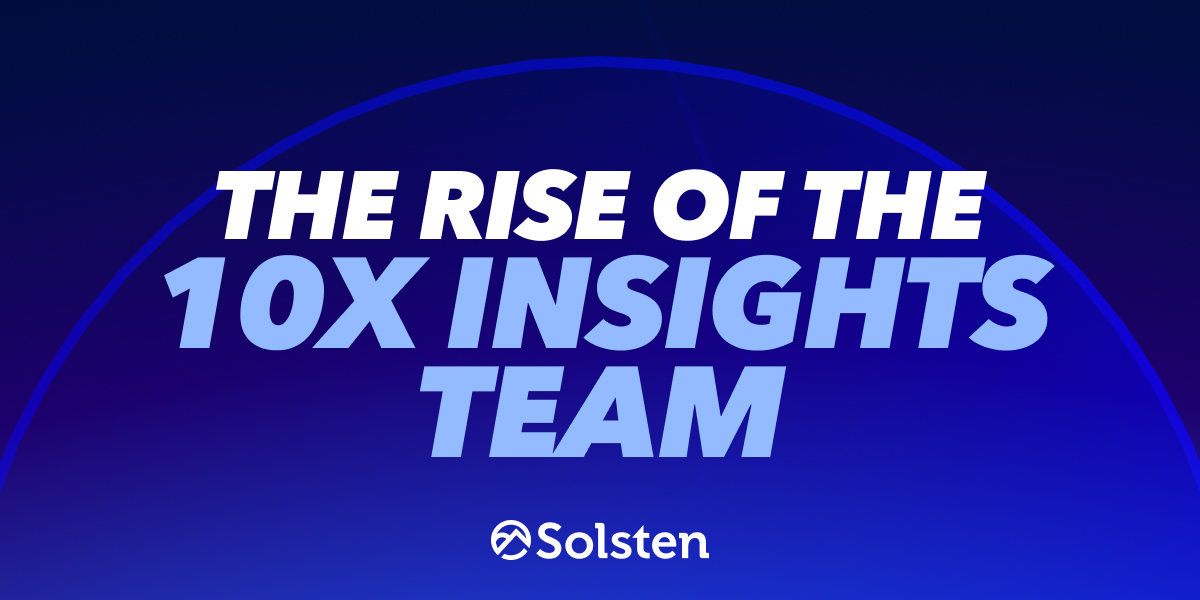Insights teams are facing unprecedented pressure to deliver deeper understanding in less time. With only 38% of marketing leaders confident they know their customers’ top motivators, the responsibility falls to insights teams to close this critical knowledge gap.
It’s no longer enough to describe who your customers are. Today’s insights teams must become architects of scalable, high-impact audience segmentation frameworks powered by behavioral science.
The best insights teams are no longer limited by research budgets but by their ability to build robust insight generation systems that enhance both the immediacy and depth of consumer understanding.
It’s time for your team to embrace it.
But first, let’s level set on what a 10x Insights Team can do.
Similar to the concept of a 10x engineer in software development, the 10x Insights Team can accomplish ten times what traditional market research approaches deliver — not by working harder, but by fundamentally transforming how they understand audiences.
What does that mean in today’s terms?
The 10x Insights Team is one that:
- Integrates psychographic segmentation to complement existing demographic models
- Uses behavioral science and validated psychometric data to understand audiences with greater predictive accuracy
- Creates repeatable ethnographic frameworks for audience discovery, need-state mapping, and experience design
- Enhances traditional research methods with psychological insights that predict behavioral patterns before they emerge in quantitative data
- Delivers actionable recommendations grounded in the underlying motivations and need-states driving consumer behavior
How does the 10x Insights Team enhance current research methodologies? Rather than replacing existing frameworks, the 10x Insights Team augments and amplifies current capabilities by integrating:
- Quantitative research with qualitative behavioral insights
- Segmentation studies with psychometric profiling
- Customer journey mapping with psychological need-states
- Brand tracking with values-based alignment measurement
- Competitive analysis with psychographic differentiation
From demographic segmentation to integrated psychographic insights
Traditional market research often forces a trade-off: do you prioritize speed or depth? Do you invest in broad quantitative studies or focused qualitative ethnographies?
But in today’s complex consumer landscape, this is increasingly a false choice.
Psychographic analysis enhances this equation when integrated with your existing research stack. Instead of replacing current methodologies, a 10x Insights Team builds systems that complement traditional segmentation with psychometric dimensions, uncovering deeper motivations while leveraging your existing research investments.
Related Reading: How Solsten’s Adaptive Psychometric Assessment Works
Audience understanding is no longer limited to demographics and observed behaviors — it’s about enriching your current insights framework with validated psychological drivers that explain the “why” behind consumer decisions.
Consider these real-world examples of organizations that enhanced their existing research with psychological insights:
Supercell needed to revitalize a product with 15 million users. By implementing psychological assessment to complement their existing analytics, they identified previously hidden motivational factors within their audience. This allowed them to refine their product strategy based on genuine psychological needs rather than just demographic patterns. The result? In just two months from implementation to results, they achieved a 22% increase in daily engagement and an 18% increase in average time spent with the product.
Mobilityware, a mobile technology company, used psychological understanding to transform their marketing approach. By applying these insights to their acquisition strategy for a new product featuring the Monopoly brand, they created messaging that resonated with their audience’s intrinsic motivations rather than just demographic targeting. The outcome was remarkable: customer acquisition costs 70-80% lower than industry averages at launch, with a 20-25% advantage maintained even 10 months later.
These examples demonstrate the core of the 10x Insights Team approach: designing intelligence frameworks that make ambitious marketing and product strategies achievable through psychological understanding that complements existing research investments.
The Enhanced Insights Integration Framework
The evolution to a 10x Insights Team typically follows three stages that complement your existing research practices:
- Augment current segmentation models – Integrate psychometric dimensions with your existing customer segmentation to understand motivations, values, and personality traits, creating a multi-layered view of your audience taxonomy.
- Enhance your insights ecosystem – Connect psychological data to your current research tools and dashboards, enriching your Voice of Customer programs, segmentation studies, and journey mapping with deeper motivational insights.
- Establish psychological validation protocols – Implement measurement systems that validate how well psychological insights predict key behavioral outcomes, creating a continuous feedback loop between observed behaviors and underlying motivations.
Related Reading: Validation and Reliability in Navigator’s Psychometric Approach
No, a 10x Insights Team doesn’t just gather data faster.
It’s more than that.
They design intelligence systems that multiply their impact, ensuring each audience insight grows more valuable over time.
Enrich traditional segmentation frameworks
A 10x Insights Team enriches existing market segmentation by integrating psychometric dimensions that complement traditional approaches. This creates a more nuanced understanding across multiple layers:
- Traditional segments (demographics, firmographics, purchase behavior)
- Psychographic dimensions (motivations, values, personality traits)
- Attitudinal factors that explain satisfaction and loyalty metrics
- Need-state mapping that reveals underlying behavioral drivers
- Competitive whitespace analysis based on psychological differentiation
How does this integrate with your current research practice?
For example, Navigator connects seamlessly with your existing segmentation models, enriching them with validated psychometric data. This allows you to maintain your established segmentation framework while adding a deeper layer of understanding about what drives consumer behavior within each segment.
This enhanced approach allows you to optimize existing research outputs — whether they’re segmentation studies, journey maps, or brand tracking — with psychological insights that make them more predictive and actionable across your organization.
You’ll start to see the possibilities are endless. These could include:
- Discovering previously hidden audience segments with high potential value
- Understanding psychological differences between your customers and competitors’
- Identifying the specific motivations and values that drive purchase decisions
- Creating marketing messages that resonate on a psychological level
Impossible-to-replicate as a competitive edge
Generic market research has made traditional marketing more competitive than ever. Psychological understanding is now the ultimate differentiation factor.
A a 10x Insights Team wins by creating impossible-to-replicate intelligence assets that includes psychological drivers, predictive insights, and deep audience empathy.
For a 10x Insights Team, differentiation is baked into audience understanding:
- Psychological intelligence (motivations, values, personality traits that drive decisions)
- Predictive power (understanding what will resonate before testing)
- Multi-dimensional perspective (seeing audiences as complex human beings, not data points)
Your brand cannot connect with every audience segment. You must choose where to focus based on psychological fit. This isn’t a limitation. It’s a strategy, and likely the best forcing function to come your way.
A 10x Insights Team builds defensible audience understanding by blending psychological insights with your brand values to create truly resonant experiences.
AI intelligence & the new audience strategy
AI-powered audience understanding is reshaping how companies connect with customers. Advanced AI systems are shifting market research from descriptive to predictive intelligence.
A 10x Insights Team prepares for this by optimizing for psychological depth:
- Structuring audience understanding to align with human decision-making processes
- Leveraging psychological data, which predicts behavior more accurately than demographics
- Building intelligence frameworks that ensure a constant flow of actionable audience insights
The EIA Framework for integrating psychological insights
Integrating psychological tools like Navigator 2 with your existing research practice requires a thoughtful approach. That’s where the EIA Framework comes in:
Enrich
Interpret
Activate
This methodology helps insights teams enhance current research outputs, improve insight delivery, and drive higher ROI from existing research investments.
E: Enrich Existing Research
The first step is to identify areas where your current research and segmentation models can be enhanced with deeper psychological understanding. This isn’t about replacing your existing work, but augmenting it with validated psychometric dimensions.
How to Implement:
- Enhance your established segmentation models with Navigator 2’s psychometric dimensions
- Cross-tabulate current customer segments with psychological profiles to reveal sub-segment opportunities
- Complement your existing brand tracking with psychological values alignment metrics
Related Reading: How Solsten Measures Consumer Psychology at Scale
I: Interpret Through Multiple Lenses
To fully leverage psychological insights, develop a multi-dimensional view of your audience by interpreting behavioral data through both traditional and psychological lenses. This creates a more nuanced understanding of consumer decision journeys.
How to Implement:
- Layer psychological need-states onto existing customer journey maps
- Analyze satisfaction and NPS metrics through the lens of psychological expectations
- Identify psychological factors that differentiate high-value customers from average ones
A: Activate Across the Organization
Psychological insights are most valuable when they enhance cross-functional collaboration. The final step is embedding these enriched insights into existing workflows across marketing, product development, and customer experience teams.
How to Implement:
- Enhance current personas with psychological dimensions that explain motivational drivers
- Supplement A/B testing programs with pre-test psychological validation
- Create measurement frameworks that connect psychological factors to established KPIs
Why the EIA Framework works
The EIA Framework creates a practical integration path between established research methodologies and advanced psychological insights. Rather than requiring teams to abandon existing investments, it enables them to enhance current frameworks with deeper motivational understanding.
By following this approach, you can maximize the value of both your current research assets and new psychological insights, creating a more holistic view of consumer behavior that drives measurable business outcomes.
The Future: From siloed insights to integrated understanding
The evolution of insights teams isn’t about replacing existing methodologies, but about creating more seamless integration between different research approaches.
Instead of maintaining separate workstreams for quantitative studies, qualitative research, and customer analytics, forward-thinking insights teams are building integrated frameworks where psychological dimensions serve as connective tissue between disparate data sources.
This integration is essential for staying competitive. The 10x Insights Team doesn’t just add another data source — they create synthesis between existing research investments and psychological understanding, ensuring that each business decision is informed by a more complete view of the consumer.
Want learn how to deeply understand your target audience? Check out our step-by-step tutorial and start turning insights into action today.
The 10x Mindset: Enrich, interpret, activate
The most successful insights teams of the next decade won’t abandon traditional research — they’ll enhance it with psychological dimensions that create a more complete understanding of consumer behavior.
The role of market research continues to evolve, and those who adapt by integrating psychological insights with existing methodologies will deliver the most value to their organizations.
Are you ready to enhance your insights ecosystem? Talk with our audience intelligence specialists today about how Navigator can complement your current research practice.



